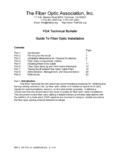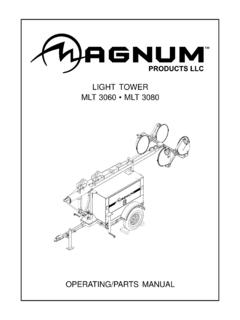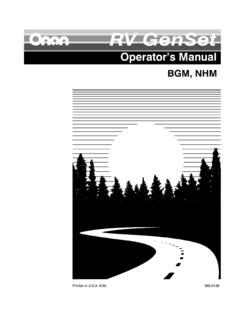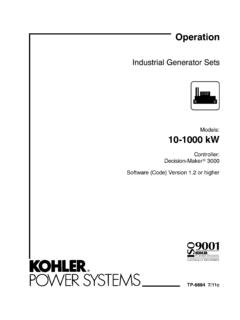Transcription of Our Ref: FCO-2458/3852 MILE END ... - Total Fire Stopping
1 Materials Science and Engineering 14 Julius Avenue, Riverside Corporate Park North Ryde NSW 2113 PO Box 310, North Ryde NSW 2113, Australia Telephone: (02) 9490 5444 Facsimile: (02) 9490 5555 ABN 41 687 119 230 THIS ASSESSMENT SUPERSEDES ASSESSMENT NUMBERED FCO-2458 DATED 11 OCTOBER 2005 Clayton +61 3 9545 2777 Highett +61 3 9252 6000 Lindfield +61 2 9413 7000 North Ryde +61 2 9490 5444 Queensland Centre for Advanced Technologies +61 73327 4444 Tidbinbilla +61 2 6201 7819 Yarralumla + 61 2 6281 8502 Our Ref: FCO-2458/3852 Promat Australia Pty Ltd 1 Scotland Road MILE END SOUTH AUSTRALIA 5031 Attention: Mr Chris Partington GENERAL SERVICE PENETRATION SYSTEMS Assessment Number FCO-2458 Your e-mail of 13 July INTRODUCTION We have examined the information referenced by you in regards to the use of fire collars for the protection of general services. The information provided includes: our sponsored investigation report numbered FSP 0626 for full-scale test on pipe penetration systems conducted on 23 November 1998; fire test report number F91633 from Warrington fire Research for a pipe penetration tests conducted on 4 December 1995; fire test report number from Warrington fire Research for a multiple pipe penetration system conducted on 12 August 2003; fire test report number from Warrington fire Research for a multiple pipe penetration system conducted on 12 August 2003; fire test report number F91754 from Warrington fire Research for cable penetrations through a concrete slab conducted on 9 January 1999; fire test report number F91611 from Warrington fire Research for pipe and electrical conduit penetration systems conducted on 14 March 1995.
2 Our sponsored investigation report numbered FSP 0863 for full-scale fire -resistance tests on pipe penetrations conducted on 31 August 2001; your letter dated 8 July 2005; and Your drawing number TL050 dated 29 July 2005. We have retained these documents and information. FCO-2458 Page 2 of 6 pages THIS ASSESSMENT SUPERSEDES ASSESSMENT NUMBERED FCO-2458 DATED 11 OCTOBER 2005 You wish to use standard fire collars to protect general services. These services include: copper pipes lagged with combustible insulation Various electrical cables Plastic pipes ANALYSIS CSIRO Sponsored Investigation report numbered FSV 0626 On 23rd November this division conducted a fire resistance test on various service penetrations through a drywall and concrete slab. Pipe A was nominal 120-mm diameter drink pipe, comprising 32-mm thick combustible insulation, ten extruded nylon beer lines and MDPE drink lines.
3 The drink pipe was open at the unexposed end and capped at the exposed end. The drink pipe projected vertically 2000-mm above the concrete slab and 500-mm into the furnace and was supported at 1000-mm intervals. The barrier system, FCM100 Floor Collar, containing one wrap of 45-mm wide and 18-mm thick Grafitex intumescent material, was retro-fitted using Hilti DBZ 6 x 38 mm Wedge anchors around the pipe on the exposed side of the concrete slab. Pipe A achieved an FRL of -/120/120 Pipe B was a nominal 100-mm diameter drink pipe, comprising 25-mm thick combustible insulation, ten extruded nylon beer lines and four MDPE drink lines. The drink pipe was open at the unexposed end and capped at the exposed end. The drink pipe projected vertically 2000-mm above the concrete slab and 500-mm into the furnace and was supported at 1000-mm intervals. The barrier system, FCM100 Floor Collar, containing one wrap of 45-mm wide and 18-mm thick Grafitex intumescent material, was retro-fitted using Hilti DBZ 6 x 38 mm Wedge anchors around the pipe on the exposed side of the concrete slab.
4 Pipe B achieved an FRL of -/120/120 Pipe C was nominal 95-mm diameter drink pipe, comprising 19-mm thick combustible insulation, ten extruded nylon beer lines and four MDPE drink lines. The drink pipe was open unexposed end and capped at the exposed end. The drink pipe projected vertically 2000-mm above the concrete slab and 500-mm into the furnace and was supported at 1000-mm intervals. The barrier system, FCM80 Floor Collar, containing one wrap of 44-mm wide and 17-mm thick Grafitex intumescent material, was retro-fitted using Hilti DBZ 6 x 38 mm Wedge anchors around the pipe on the exposed side of the concrete slab. Pipe C achieved an FRL of -/120/120 Pipe D was nominal 88-mm diameter drink pipe, comprising 19-mm thick combustible insulation and twelve MDPE drink lines. The drink pipe was open at the unexposed end and capped at the exposed end. The drink pipe projected vertically 2000-mm and 500 mm into the furnace and was supported at 1000-mm intervals.
5 The barrier system, FCM80 Floor Collar, containing one wrap of 44-mm wide and 18-mm thick Grafitex intumescent material, was retro-filled Hilti DBZ 6 x 38 mm Wedge anchors FCO-2458 Page 3 of 6 pages THIS ASSESSMENT SUPERSEDES ASSESSMENT NUMBERED FCO-2458 DATED 11 OCTOBER 2005 around the pipe on the exposed side of the concrete slab. Pipe D achieved an FRL of -/120/120 Pipe E was nominal 100 mm diameter drink pipe, comprising 25-mm thick combustible insulation, ten extruded nylon beer lines and four MDPE drink lines. The drink pipe was open at the unexposed end and capped at the exposed end. The drink pipe projected horizontally 2000-mm away from the plasterboard wall and 100-mm into the furnace and supported at 1000-mm intervals. The barrier system, FCM80 Floor Collar, containing one wrap of 44-mm wide and 18-mm thick Grafitex intumescent material, was retro-filled Hilti DBZ 6 x 38 mm Wedge anchors around the pipe on the exposed side of the concrete slab.
6 Pipe E achieved an FRL of -/120/120 Pipe F was nominal 120-mm diameter drink pipe, comprising 25-mm thick combustible insulation, ten extruded nylon beer lines and four MDPE drink lines. The drink pipe was open at the unexposed end and capped at the exposed end. The drink pipe projected horizontally 2000-mm away from the plasterboard wall and 100-mm into the furnace and supported at 1000-mm intervals. The barrier system, FCM100 Floor Collar, containing one wrap of 44-mm wide and 18-mm thick Grafitex intumescent material, was retro-filled Hilti DBZ 6 x 38 mm Wedge anchors around the pipe on the exposed side of the concrete slab. Pipe F achieved an FRL of -/90/90 Warrington fire Research report number and On 12 August 2003 Warrington fire Research performed a fire resistance test on six service penetrations through a plasterboard wall. Specimen E was nominal 100-mm diameter hole in the plasterboard wall comprised three 19-mm diameter x 1-mm thick copper pipes in a trifoil configuration.
7 Each pipe was insulated for the full length with 40-mm diameter x 9-mm thick combustible insulation. This in turn was sheathed through the penetration with 6-mm thick PROMASEAL FlexiWrap and encased with galvanized steel. PROMASEAL Acrylic sealant was used to seal any annular gaps. Specimen E achieved an FRL of -/240/120 Specimen I was nominal 100-mm diameter hole in the concrete slab comprised three 19-mm diameter x 1-mm thick copper pipes in a trifoil configuration. Each pipe was insulated for the full length with 40-mm diameter x 9-mm thick combustible insulation. This in turn was sheathed through the penetration with 6-mm thick PROMASEAL FlexiWrap. Any gaps were backfilled with concrete. Specimen I achieved an FRL of -/240/90. Insulation failure at 111 minutes was on the slab and not on the service itself Warrington fire Research report number F91633 Prior to this, on 4 December 1995 Warrington fire Research performed a fire resistance test on service penetrations through a plasterboard partition.
8 Specimen B was nominal 60-mm diameter hole in the plasterboard wall was penetrated with a 19-mm copper pipe insulated for the full length with Aeroflex insulation. Where this passed through the plasterboard partition the gap of approximately 10mm was filled with Grafitex paste for the full depth (32-mm). Specimen B achieved an FRL of -/120/120. The test was discontinued at the request of the sponsor with no failures. FCO-2458 Page 4 of 6 pages THIS ASSESSMENT SUPERSEDES ASSESSMENT NUMBERED FCO-2458 DATED 11 OCTOBER 2005 The intumescent fire collars are primarily designed for plastic pipes but they can also provide integrity protection for systems incorporating multiple conduits, metal pipes and electrical services. While FSP 0626 uses intumescent fire collars for drink lines, these drink lines have many small plastic pipes within as well as a sheathing of combustible insulation. This penetration has all been closed off with the intumescent collar used as a retrofit externally mounted to the wall/floor.
9 In fire test reports numbered 41027 it is shown that when using much thinner intumescent strips (6-mm), this will protect copper pipes lagged with combustible insulation and will provide full integrity and insulation criteria for a minimum of 120 minutes. These services are protected within the element, either concrete slabs or plasterboard partitions. In effect the thin intumescent is proven to be suitable for lagged copper pipes, while the plastic pipes and various cables have been shown to be suitably protected using thicker intumescent. In all cases products used within this assessment will use intumescent of minimum thickness of 12-mm. Table 1 Collar type Floor Wall Drawing Ref FC40-100 Retro fit Retro fit Figs 1 & 2 FCS40-100 Retro fit Retro fit Figs 1 & 2 UniCollar 40-100 Retro fit Retro fit Figs 1 & 2 FCW 40-100 Insert Fig 3 CONCLUSION/OPINION Based on the significant quantity of test data, it is the opinion of this division that the Promat range of fire collars (provided that they have achieved an FRL of at least -/120/120 when tested with uPVC plastic pipes)
10 Shown in table 1 and limited to 100-mm internal diameter would be capable of achieving fire -resistance levels of -/120/120 when used in conjunction with PVC-insulated and sheathed power and communication cables with copper conductors, uPVC pipes and copper pipes lagged with combustible insulation and tested in accordance with AS These collars must be installed into masonry or framed walls on minimum -/120/120 FRL as per manufacturer s instructions and the attached drawing numbered TL050 Where gaps are formed due to the geometry of the services, these gaps shall be sealed using trowel grade Grafitex intumescent paste. FCO-2458 Page 5 of 6 pages THIS ASSESSMENT SUPERSEDES ASSESSMENT NUMBERED FCO-2458 DATED 11 OCTOBER 2005 TERM OF VALIDITY This opinion will lapse on the 31 March 2015. Should you wish for us to re-examine this opinion with a view to the possible extension of its term of validity, please apply to us 3 months before the term is due to expire.





